How to break through the blockade of Leningrad
Beginning of the offensive
On the morning of January 12, 1943, troops of two fronts simultaneously launched an offensive. Soviet night before aviation dealt a powerful blow to the positions of the Wehrmacht in the breakthrough strip, as well as to airfields, command posts, communications and railway junctions in the enemy rear. Tons of metal fell upon the Germans, destroying its manpower, destroying defensive structures and suppressing fighting spirit. At 9 o’clock. 30 minutes artillery preparation began: in the offensive zone of the 2nd shock army, it lasted 1 hour 45 minutes, and in the sector of the 67th army - 2 hours 20 minutes. 40 minutes before the start of the movement of infantry and armored vehicles, attack on previously explored artillery, mortar positions, strongholds and communications centers was launched by attack aircraft, in groups of 6-8 aircraft.
At 11 o’clock. 50 minutes under the cover of the “fire rampart” and the fire of the 16th fortified area of the division of the first echelon of the 67th army went on the attack. Each of the four divisions - the 45th Guards, 268th, 136th, 86th Rifle Divisions, was reinforced by several artillery and mortar regiments, a fighter-anti-tank artillery regiment and one or two engineering battalions. In addition, the attack was supported by 147 lungs. tanks and armored cars whose weight could withstand the ice. The particular difficulty of the operation was that the defensive positions of the Wehrmacht went along the steep icy left river bank, which was higher than the right. The Germans' firepower was tiered and covered with multi-layer fire all the approaches to the shore. To break through to the other side, it was necessary to reliably suppress the firing points of the Germans, especially in the first line. At the same time, it was necessary to ensure that the ice on the left bank was not damaged.
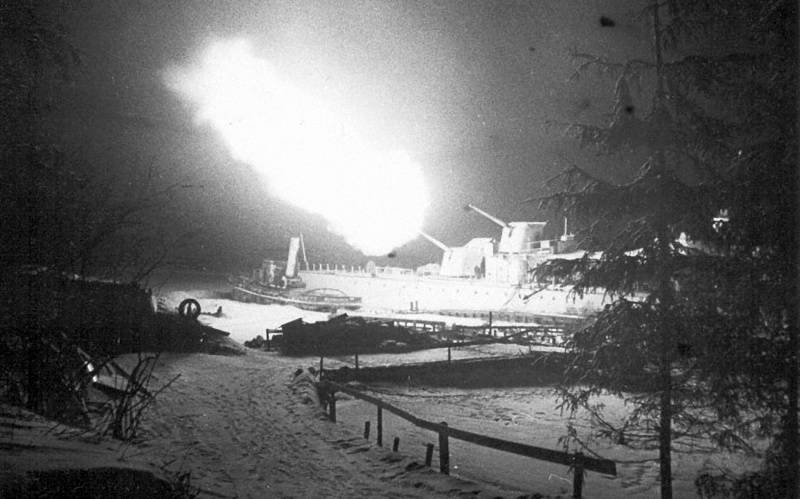
Baltic destroyer fleet "Experienced" is firing enemy positions in the Nevsky Forest Park. January 1943
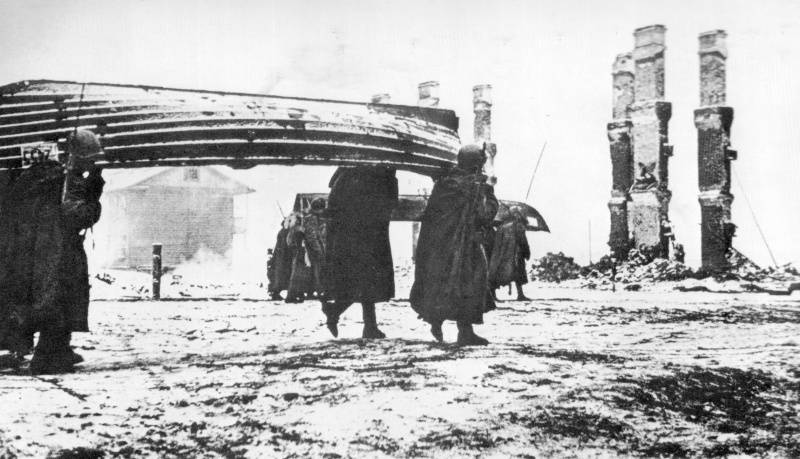
Soviet soldiers carry boats for crossing the Neva River
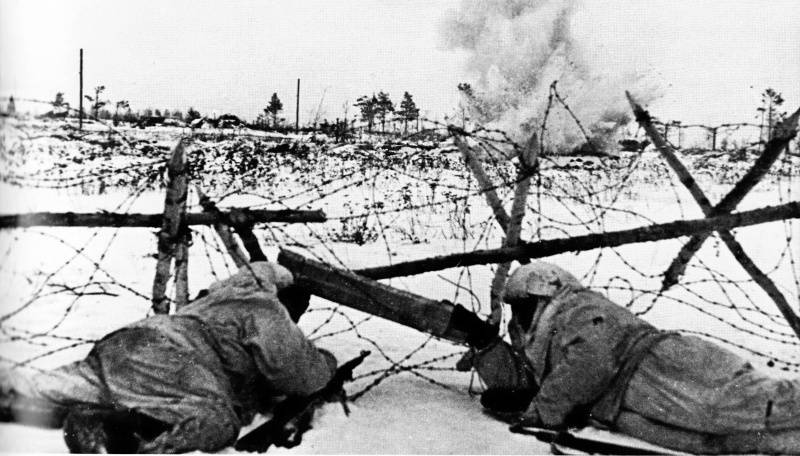
The scouts of the Leningrad front during the battle at the wire barriers
The first to the other side of the Neva were the assault groups. Their fighters selflessly made passages in the barriers. Behind them crossed the river infantry and tank units. After a fierce battle, the enemy defense was hacked north of the 2-th Gorodok (268-Rifle Division and 86-th separate tank battalion) and in the Marino area (136-division and 61-th tank brigade formations). By the end of the day, Soviet troops had broken down the resistance of the 170 of the German infantry division between the 2 Township and Shlisselburg. 67-I army captured the bridgehead between 2-Gorodok and Shlisselburg, construction began crossing for medium and heavy tanks and heavy artillery (completed 14 January). On the flanks, the situation was more difficult: on the right wing, the 45-I Guards Rifle Division in the Nevsky Pyatachka area was able to capture only the first line of German fortifications; on the left wing, the 86-Infantry Division was unable to force the Neva near Shlisselburg (it was transferred to a bridgehead in the Marino area to strike Shlisselburg from the south).
In the offensive zone of the 2 shock and 8 armies, the offensive developed with great difficulty. Aviation and artillery could not suppress the main firing points of the enemy, and the swamps, even in winter, were impassable. The most fierce battles were behind the Lipka, Workers' Settlement No. 8 and Gontovaya Lipka points; these strong points were on the flanks of the bursting forces and even in full surroundings continued the battle. On the right flank and in the center - 128-I, 372-I and 256-I infantry divisions, could by the end of the day break through the defense of 227-th infantry division and advance 2-3 km. The strongholds of Lipka and Working Village No. 8 on this day could not be taken. On the left flank, only the 327-Infantry Division was able to achieve some success, which occupied most of the fortifications in the Roundwood grove. The attacks of the 376 Division and the forces of the 8 Army did not succeed.
The German command, on the first day of the battle, was forced to deploy operational reserves: the connections of the 96 Infantry Division and the 5 Mountain Division were sent to the aid of the 170 Division, two regiments of the 61 Infantry Division (Major General Hüner) were introduced into the center of the Schlesselburg-Sinyavino ledge.
Battle 13 - January 17
On the morning of January 13, the offensive continued. The Soviet command to finally turn the tide in their favor began to enter into the battle the second echelon of the advancing armies. However, the Germans, relying on strongholds and a developed defense system, put up stubborn resistance, constantly counterattacking, trying to restore their lost position. The fighting took a protracted and bitter character.
In the offensive zone of the 67 Army on the left flank, the 86 Infantry Division and the battalion of armored vehicles, supported by the 34 Ski Brigade and 55 Infantry Brigade (on the ice of the lake) from the north, stormed the approaches to Shlisselburg. By the evening of 15, the Red Army men reached the outskirts of the city, the German troops in Shlisselburg were in a critical situation, but continued to fight hard.
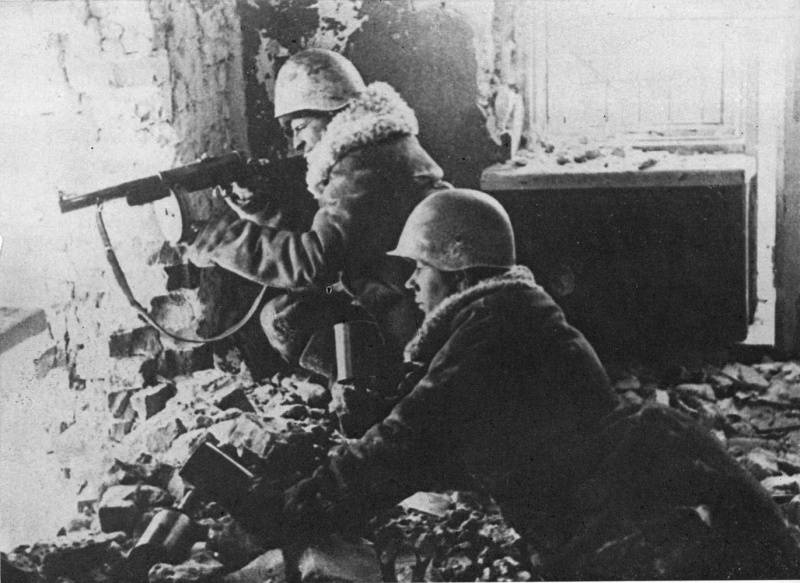
Soviet fighters in battle on the outskirts of Shlisselburg
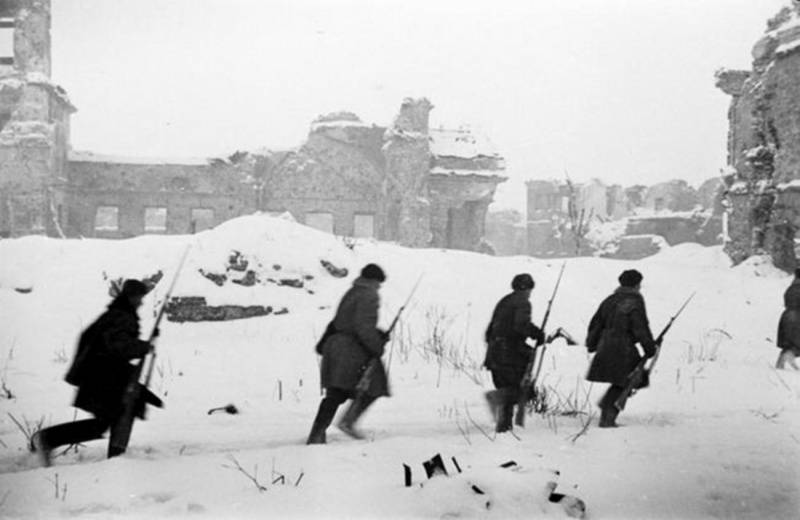
Fighters of the 67 Army of the Leningrad Front are moving through the territory of the Schlusselburg Fortress
In the center of the 136-th Infantry Division and 61-I tank tank brigade developed an offensive in the direction of the workers' village number 5. To ensure the left flank of the division, the 123 Infantry Brigade was brought into battle, it had to advance in the direction of the workers' settlement No. 3. Then, to ensure the right flank, the 123 Infantry Division and the tank brigade were brought into battle, they were advancing in the direction of Workers' Settlement No.6, Sinyavino. After several days of fighting, the 123-I rifle brigade seized Working Village No. 3 and reached the outskirts of the settlements No. 1 and No. 2. The 136 Division made its way to Workers' Settlement No. 5, but could not immediately take it.
On the right wing of the 67 Army, the 45 Guards and 268 Rifle Divisions were still unsuccessful. The air force and artillery could not eliminate the firing points in the 1-m, 2-m Gorodok and 8-th GRES. In addition, German troops received reinforcements - the formations of the 96 th infantry and 5 th mountain rifle divisions. The Germans even made fierce counterattacks, using the 502 heavy tank battalion, armed with the Tiger I heavy tanks. Despite the introduction of the second echelon of the 13 th infantry division, the 102 th and 142 th infantry brigades, the Soviet troops failed to turn the tide in this sector in their favor.
In the band of the 2 shock army, the offensive continued to develop more slowly than in the 67 army. The German troops, relying on the strong points - The workers' villages No. 7 and No. 8, Lipka, continued to put up stubborn resistance. 13 January, despite the introduction into the battle of the forces of the second echelon, the troops of the 2 th shock army did not achieve any serious success in any direction. In the following days, the army command attempted to widen the breakthrough in the southern sector from the Kruglaya grove to Gaitolovo, but without visible results. The 256-Infantry Division was the most successful in this area, in January 14 it occupied Working Village No. 7, Podgornaya Station and reached the approaches to Sinyavino. On the right wing, the 128 I ski brigade was sent to the aid of the 12 Division, it had to go to the rear of the Lipka stronghold on the ice of Lake Ladoga.
On January 15, in the center of the offensive line, the 372 Rifle Division was finally able to take on the workers' villages No. 8 and No. 4, and the 17-2 went to the village No. 1. To this day, the 18-I Rifle Division and the 98-I tank tank brigade 2 UA have been fighting hard for several days on the approaches to Working Village No. 5. He was attacked from the west by units of the 67 Army. The moment of connection of the two armies was close.
Breakthrough blockade. Fights 18 - January 20
By January 18, the troops of the Leningrad and Volkhov fronts fought a fierce battle in the vicinity of Working Village No. 5, and they were only a few kilometers apart. The German command, realizing that it was no longer necessary to keep the surrounded strongholds, gave the order to the garrisons of Shlisselburg and Lipki to break through to Sinyavino. In order to facilitate the breakthrough, the forces that defended the Workers ’Settlements No. 1 and No. 5 (the Hüner Group) had to hold on as long as possible. In addition, a counterattack was organized from the area of Working Village No. 5 for the 136 th Infantry Division and the 61 th separate tank brigade to overturn it and facilitate the breakthrough of the encircled troops. However, the blow was reflected, it was destroyed before 600 of the Germans, they captured up to 500 people. The Soviet soldiers, pursuing the enemy, broke into the village, where at about noon 12 hours of the day the troops of the 2 shock and the 67 army joined. The troops of the two armies met in the area of the Worker settlement No. 1 - these were the 123-I separate rifle brigade of the Leningrad Front led by the deputy commander for political affairs Major Melkonian and the 372-I rifle division of the Volkhov Front led by the head of the 1 branch of the division headquarters Major Melnikov. On the same day Shlisselburg was completely cleared from the Germans, and by the end of the day the southern coast of Lake Ladoga was freed from the enemy, and its isolated groups were destroyed or captured. Lipki was also released.
“I saw,” recalled G.K. Zhukov, - with what joy the fighters of the fronts who broke through the blockade rushed towards each other. Not paying attention to the artillery shelling of the enemy from the Sinyavinsky heights, the soldiers fraternally hugged each other tightly. It was truly a joy to suffer! ”Thus, on January 18 on January 1943, the blockade of Leningrad was broken.
V. Serov, I. Silver, A. Kazantsev. Breakthrough blockade of Leningrad. 1943
However, it was impossible to say that the situation has fully stabilized. The general front of the 67 and 2 of the shock armies was not sufficiently dense, so part of the surrounded German troops (about 8 thousand people), leaving heavy weapons and dispersed, broke through the workers' settlement No. 5 in the southern direction and by January 20 to Sinyavino. The German command diverted the retreating troops to the previously prepared positions along the Gorodok line number 1 and number 2 - Workers settlement No. 6 - Sinyavino - the western part of the Round Grove. There, in advance, the SS Police Division, the 1 Infantry Division and the 5 Mountain Division infantry units were deployed. Later, the command of the 18 of the German army strengthened this line with units of the 28 th chasseurs, 11 th, 21 th and 212 th infantry divisions. The command of the 67 Army and the 2 Shock Army did not exclude the possibility of the enemy conducting a counter-offensive in order to restore the lost positions. Therefore, the troops of the two armies stopped offensive operations and began to consolidate on the achieved lines.
On January 18, as soon as Moscow received news of the blockade breaking, the State Defense Committee decided to accelerate the construction of a railway line on the liberated strip of land, which was supposed to connect Leningrad with the Volkhovsky railway junction. The railway from Polyana station to Shlisselburg should have been built in 18 days. At the same time, a temporary railway bridge was built across the Neva. The railway line was called the Victory Road. Already in the morning of February 7, Leningrad residents greeted the first train echelon with great joy, which came from the mainland and delivered 800 t. Butter. In addition, car traffic began to function along the southern shore of Lake Ladoga. The Road of Life continued to operate. Two weeks later, in Leningrad, food supply standards set for the largest industrial centers of the country began to operate: workers began to receive 700 — 600 grams of bread per day, employees — by 500, children and dependents — 400 grams. Increased rates of supply of other types of food.
True, the Victory Road operated in the most difficult conditions. German artillery shot through the narrow corridor cleared by Soviet troops, as the path passed 4 — 5 km from the front line. Compositions had to be led under bombardment and artillery fire. It happened that the splinters struck both the machinists, the stokers, and the conductors. Repair of the tracks was often done by improvised means. With the onset of summer, the trains, contrary to all existing rules, moved along the hub in the water. As a result of shelling and bombing, the railway communication was often broken. The main cargo flows still went along the Road of Life through Ladoga. In addition, there was a threat that the Germans would be able to restore the situation.
Thus, the largest political, economic, and cultural center of the USSR, after a very tough 16 month-long struggle, regained its land connection with the country. The supply of the city with food and essential goods was significantly improved, and industrial enterprises began to receive more raw materials and fuel. As early as February 1943, the generation of electricity increased dramatically in Leningrad, and the production of weapons increased markedly. The restoration of communications allowed us to continuously strengthen the troops of the Leningrad Front and the Baltic Fleet with reinforcements, armaments and ammunition. This improved the strategic position of the Soviet forces operating in the north-western direction.
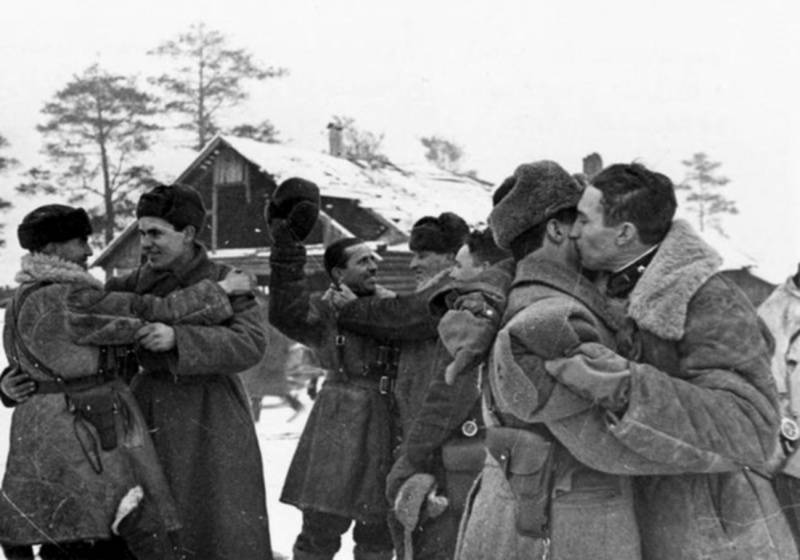
Meeting of the fighters of the Leningrad and Volkhov fronts at the workers' settlement №1 during the operation to break the blockade of Leningrad
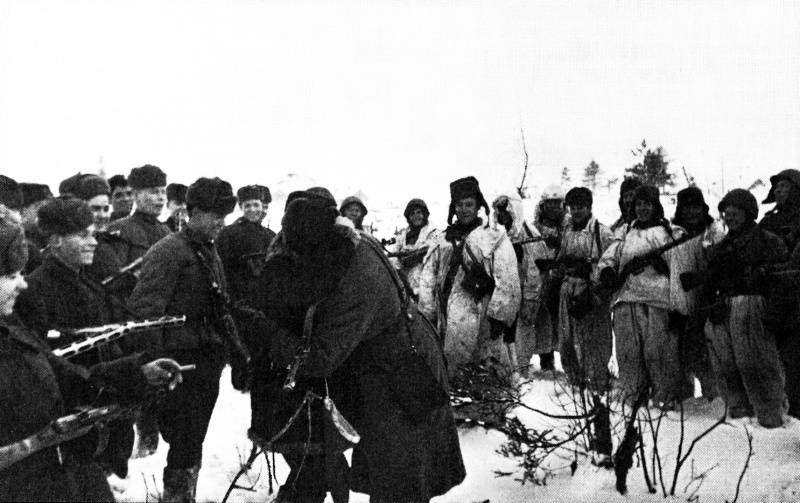
Meeting of the fighters of the Leningrad and Volkhov fronts near the workers' settlement №5 during the operation to break the blockade of Leningrad
The continuation of the offensive. 20 - January 30
After the troops of 67 and 2 of the shock army formed a common front and entrenched on the new frontiers, it was decided to continue the operation and reach the Mustolovo-Mikhailovsky line (along the Moika river), and then seize the Kirov railway. On January 20, Zhukov reported to Stalin the plan of the Mga operation, prepared jointly with Voroshilov, Meretskov and Govorov.
However, the German command had already managed to prepare well for a possible Soviet offensive. A previously prepared defensive line was defended by 9 divisions, significantly supported by artillery and aircraft. The enemy redeployed 11 and 21 infantry divisions under Sinyavino, exposing the rest of the front to the limit: from Novgorod to Pogostya, near Leningrad and Oranienbaum, Lindemann left 14 infantry divisions. But the risk paid off. In addition, the advancing Soviet armies were deprived of maneuver, and they had to attack the enemy’s positions head-on. The formations of the Soviet armies were already heavily exhausted and drained of blood by the previous brutal battles for the Schlüsselburg-Sinyavino ledge. It was difficult to count on success in such conditions.
January 20 after the artillery preparation of the army went on the offensive. The 67 Army, 46, 138 Rifle Divisions and 152 Tank Brigade, struck south-east of 1 and 2 Townships. The army was to capture Mustolovo and bypass Sinyavino from the west. The 142 Brigade of the Marine Corps, the 123 Brigade, attacked Sinyavino. The 123 Rifle Division, the 102 Rifle Division, and the 220 Tank Brigade had the task of breaking the enemy’s resistance in the 1 and 2 Township areas and reaching Arbuzovo. But the Soviet troops met with strong resistance and could not solve the tasks. Successes were insignificant. The Commander-in-Chief Govorov decided to continue the attacks and isolated from the reserve of the front 4 rifle divisions, 2 rifle divisions and 1 tank brigades. On January 25, the troops went on the offensive again, but, despite the reinforcements entering the battle, they failed to break through the German defenses. The stubborn fighting continued until the end of January, but the 67-I army could not break the German order.
Events in the area of the 2 shock army developed in a similar way. The troops were forced to attack in the marshland, which deprived them of proper support for artillery and tanks. German troops, relying on strong positions, put up fierce resistance. 25 January 2-I Shock Army Pitch to seize Working Village No. 6. Until the end of the month, parts of the army fought hard for the Sinyavino heights, part of the Kruglaya grove and the Kvadratnaya grove in the area of the Worker settlement No. 6. January 31 The 80-Infantry Division was even able to occupy Sinyavino, but the German troops drove it out with a strong counterattack. In other areas the army was not very successful.
By the end of the month, it became clear that the offensive had failed and the plan for the liberation of the Neva and the Kirov railway was not yet implemented. The plan needed a strong adjustment, the position of the Germans on the line: the 1 and 2 cities - Sinyavino - Gaitolovo, turned out to be too strong. In order to rule out possible attempts by the enemy to restore the blockade, the troops of the 67 and 2 attack armies of 30 in January went over to the defenses to the north and east of 2 Township, to the south of Working Village No. 6 and to the north of Sinyavino, to the west of Gonta Lipka and east of Guitolovo. The troops of the 67 Army continued to hold a small bridgehead on the left bank of the Neva near Moscow Dubrovka. The Soviet command is beginning to prepare a new operation, which will be held in February 1943.
Report of the Soviet Information Bureau on Breaking the Siege of Leningrad
Results of the operation
The Soviet troops created a “corridor” along the shore of Lake Ladoga 8 – 11 km wide, broke through a long enemy blockade that stifled Leningrad. There was an event that all Soviet people had been waiting for so long. There was a land connection between the second capital of the USSR and the Great Land. The military-strategic plans of the German military-political leadership regarding Leningrad were thwarted - the city was supposed to be “cleaned up” from the inhabitants by a long blockade, famine. The possibility of a direct connection of the German and Finnish troops east of Leningrad was disrupted. The Leningrad and Volkhov fronts received direct communication, which increased their combat capabilities and significantly improved the strategic position of the Red Army in the north-west direction. Thus, the operation "Iskra" became a turning point in the battle for Leningrad, from that moment the strategic initiative was completely transferred to the Soviet troops. The threat of storming the city on the Neva was excluded.
It should be noted that the breakthrough of the blockade of Leningrad was a serious blow to the prestige of the Third Reich in the world. It’s not for nothing that the military observer of the British agency Reuters noted that “the breakthrough of the German fortified line south of Lake Ladoga is the same blow to A. Hitler’s prestige as the crushing defeat of the German troops at Stalingrad”.
American President F. Roosevelt, on behalf of his people, sent a special diploma to Leningrad "... in memory of his valiant warriors and his faithful men, women and children, who, being isolated by the invader from the rest of his people and despite the constant bombardment and unspeakable suffering from of cold, hunger and disease, successfully defended their beloved city during the critical period from September 8 1941 to January 18 on 1943, and symbolized the fearless spirit of the peoples of the Union of Soviet Socialist Republics ublik and all the peoples of the world who are resisting the forces of aggression. "
The Soviet soldiers in this battle showed increased military skill, defeating the troops of the German 18. For courage and heroism shown in battles with the Nazis, 25 soldiers were awarded the high title of Hero of the Soviet Union, about 22 thousand soldiers and commanders were awarded orders and medals. Supreme Commander I.V. Stalin in the order from 25 January 1943 for successful fighting to break the blockade of Leningrad announced his gratitude to the troops of the Leningrad and Volkhov fronts, congratulated them on the victory won over the enemy. For courage and heroism of the personnel 136-I (commander Major General N. P. Simonyak) and 327-I (commander Colonel N. A. Polyakov) rifle divisions were transformed into 63 and 64 guards rifle divisions, respectively. The 61-I tank brigade (commander Col. V. V. Khrustitsky) was transformed into the 30-th Guards Tank Brigade, and the 122-nd Tank Brigade was awarded the Order of the Red Banner.
The fact of the difficult conditions under which the operation took place and the losses of the German defense on this sector of the front speak well of. Soviet troops lost 12-30 in January (Operation Iskra) to 115 082 people (33 940 lost them). The losses of the Leningrad Front are 41264 people (12320 are dead), and the Volkhovsky are 73818 people (21620 is irrevocable). During the same period, the 41 tank (according to other sources, more than 200), 417 guns and mortars and the 41 aircraft were lost. The Germans have reported on the destruction of 847 tanks and 693 aircraft (for the period of January 12 - April 4). Soviet sources report that over the period 12 - 30 of January, the Germans lost more than 20 thousand people killed, wounded and captured. Soviet troops 7 enemy divisions.
At the same time, the Soviet troops could not complete the operation victoriously. Army Group North was still a serious adversary, and the German command responded promptly to the loss of the Schlisselburg-Sinyavino overhang. The Soviet strike groups were weakened by fierce battles for a heavily fortified area and could not break into the new German defensive line. The defeat of the German-Sinyavin German group had to be postponed until February 1943. Leningrad, after breaking the blockade, another year was under siege. The only way to completely free the city on the Neva from the German blockade was in January 1944 during the operation “January Thunder”.
Monument "Broken Ring" of the Green Belt of Fame defenders of Leningrad. The authors of the memorial: the author of the monument to sculptor K.M. Simun, architect V.G. Filippov, design engineer I.A. Rybin Opened 29 October 1966
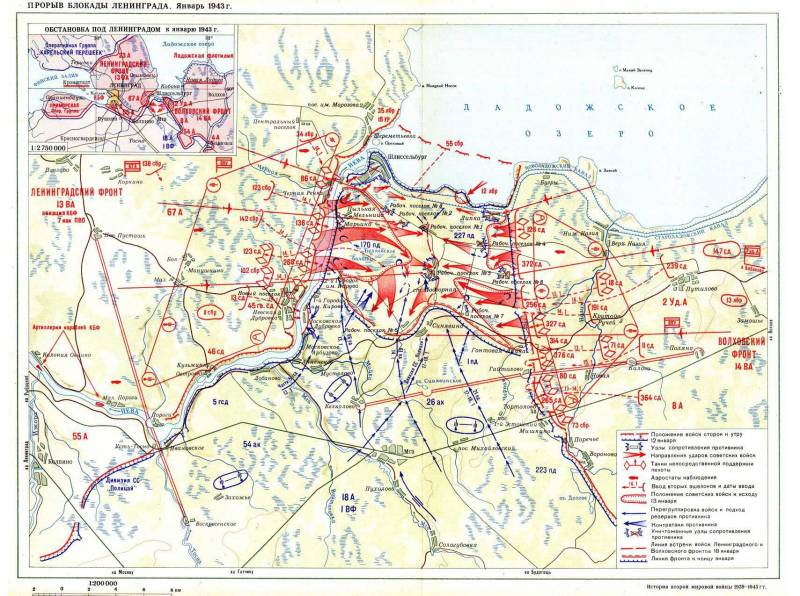
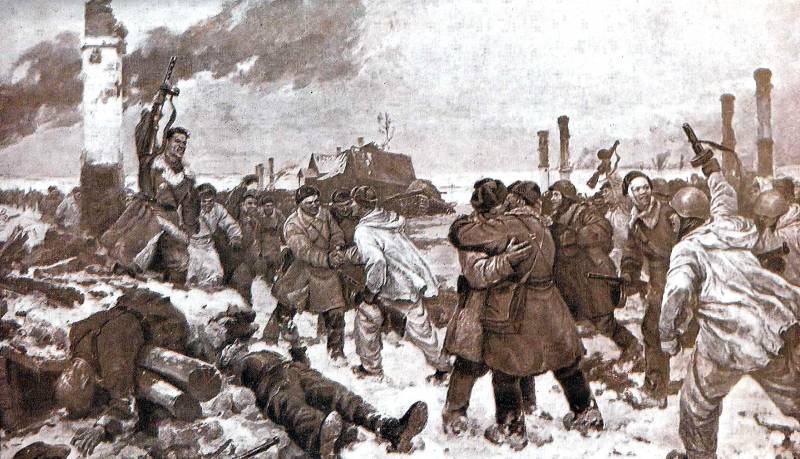
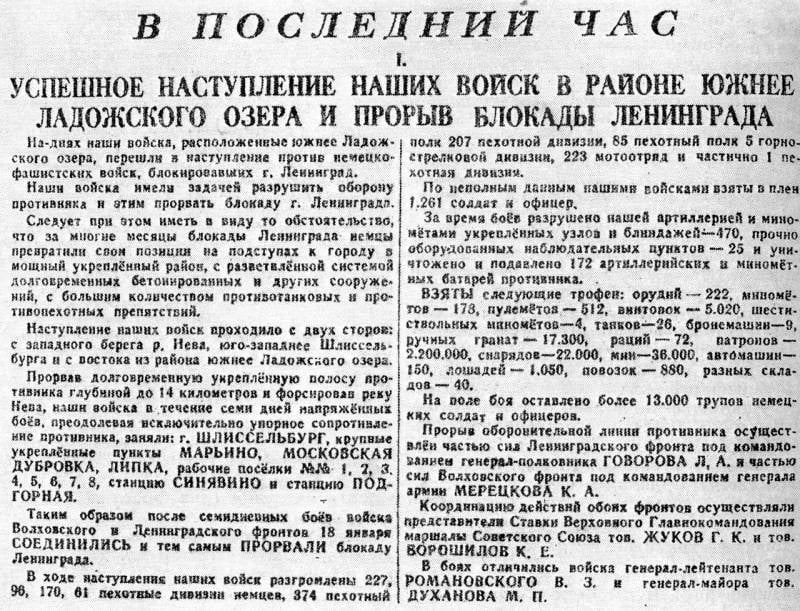
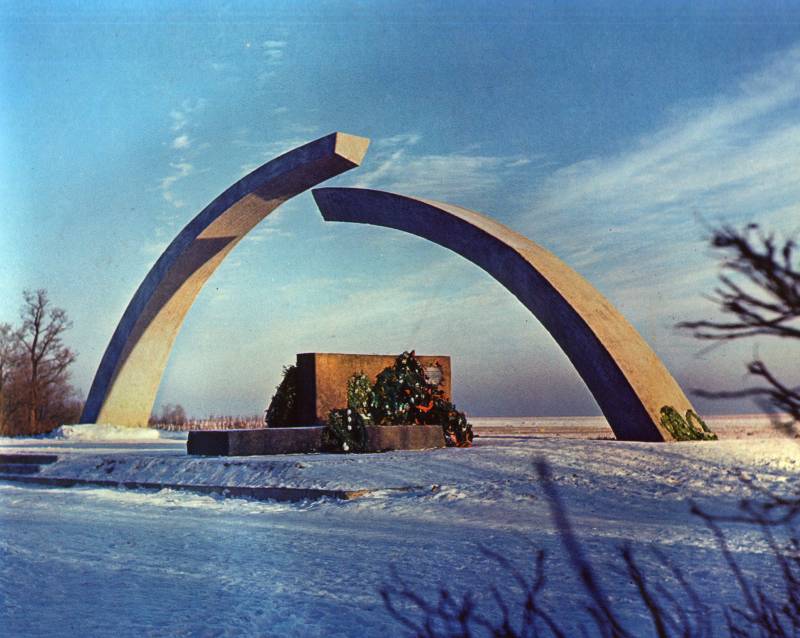
Information